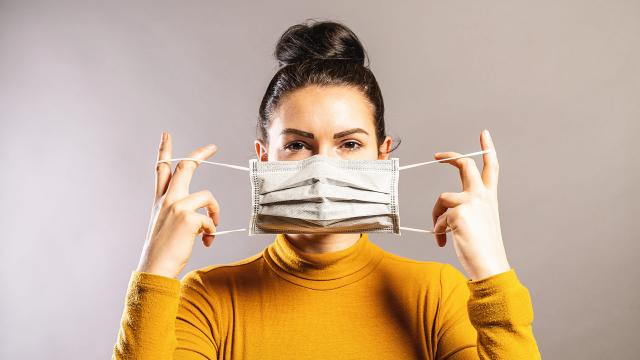Masks protect us. That shouldn’t be a surprise at this point, but since there’s been so much confusion about what masks do, and there are a lot of myths floating around about them, it’s time for a little refresher.
Masks reduce the spread of droplets coming out of your face
Masks, properly worn, do block most of the larger droplets coming out of your mouth and nose. This is important because droplets carry the virus, and you can be infected and contagious without realising it. By the time you feel sick with COVID-19 symptoms, you have probably been spreading the virus for a day or so.
That means that even if you feel fine, wearing a mask reduces the chances that you may accidentally make others sick. If everybody wears a mask, the virus has very few opportunities to pass from person to person.
Masks do not block every droplet, because some are small enough to get through the weave of the mask and because the edges of the mask don’t usually make a complete seal. Bottom line, masks help, but they do not provide perfect protection for you or for others.
Also: masks do not block carbon dioxide, so you don’t have to worry about the mask slowly suffocating you. They do not cause or worsen infections. These are myths unsupported by science.
Masks may provide a small amount of protection from other people’s droplets
You should not expect a cloth mask to protect you from other people’s droplets, but that’s a possible bonus of wearing one. If you need extra protection — for example, you’re in a high risk group and yet need to be around other people — a surgical mask is a more effective. An N95, if you can get one, is better still. Whichever mask you wear, combining it with a clear plastic face shield will give you some extra protection from other people’s droplets.
[referenced url=”https://www.lifehacker.com.au/2020/06/should-you-wear-a-clear-plastic-face-shield/” thumb=”https://www.gizmodo.com.au/wp-content/uploads/sites/4/2020/06/26/lrkl782ozcwjnwlncqus-300×169.jpg” title=”Should You Wear a Clear Plastic Face Shield?” excerpt=”Face masks are one of the essential tools we can use to keep each other safe as things reopen. But what about face shields? These are clear plastic and provide a splash-proof barrier for your face. They can be a good addition to face masks, but they aren’t a replacement.”]
What happens if I don’t wear a mask?
If you are infected, which you might not realise until it is too late, you could spread the virus to others through droplets from your breath. You might also (possibly) spread the virus from your mouth to your hands and then to another person’s hands or to a shared surface. (Transmission seems to be mainly through respiratory droplets, but the risk of surface contamination can’t be ruled out.)
Even if you are not infected, going maskless may slightly increase your chances of catching the virus from someone else. Slightly.
A crowd of maskless people (say, at a bar) is like a trading post for viruses. You might pick up the virus, or somebody might pick it up from you. After that, whoever got infected then carries the virus home to potentially infect their family, their friends or the people they meet at the next bar/trading post.
All this is to say, if you must shop or socialise, do it with a mask when travelling in high risk areas. Transmission resulting from maskless spread is the kind of thing that shuts businesses down again.
Important limitations
Masks do a lot for us, but they aren’t a magical force field. Remember these caveats:
- You have to wear them properly (that means over your mouth and nose).
- N95s are better than surgical masks, which are better than cloth masks. But wearing a cloth mask frees up the medical varieties for healthcare workers who need them most.
- No mask provides perfect protection.
- Even if you wear a mask, everything else you’re supposed to be doing (hand washing, distancing, staying home) is still important.

Leave a Reply
You must be logged in to post a comment.